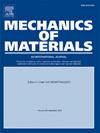Machine learning-boosted nonlinear homogenization
IF 3.4
3区 材料科学
Q2 MATERIALS SCIENCE, MULTIDISCIPLINARY
引用次数: 0
Abstract
Previous research has established nonlinear homogenization as an efficient technique for deriving macroscopic constitutive relations and field statistics in heterogeneous (i.e. composite) materials. This method involves optimal linearization of the nonlinear composite, resulting in a best linear comparison composite that shares identical microstructure and field statistics with the nonlinear material. However, the computational time associated with this method increases as the fidelity of the material representation improves, limiting its practical implementation in commercial finite element software for large-scale structural calculations in which a Representative Volume Element must be considered at each integration point. To overcome this limitation without sacrificing precision or efficiency, machine learning can be employed to develop a digital twin of the homogenization-based constitutive law. This approach enables real-time prediction of macroscopic material behavior while maintaining accuracy. The effectiveness of this approach has been demonstrated for two-phase composites with nonlinear power-law constitutive relations, and it has been successfully extended to model the complex three-dimensional behavior of viscoplastic polycrystals. In the latter case, a significant reduction in computational time has been achieved without compromising the precision of nonlinear homogenization method outputs.
机器学习促进的非线性均匀化
以往的研究已经建立了非线性均匀化作为一种有效的技术来推导宏观本构关系和场统计在非均质(即复合)材料。该方法涉及非线性复合材料的最优线性化,从而得到与非线性材料具有相同微观结构和场统计的最佳线性比较复合材料。然而,随着材料表示保真度的提高,与该方法相关的计算时间增加,限制了其在商业有限元软件中的实际实施,用于大规模结构计算,其中必须在每个集成点考虑代表性体积单元。为了在不牺牲精度或效率的情况下克服这一限制,可以使用机器学习来开发基于均质化的本构律的数字孪生。这种方法可以实时预测宏观材料的行为,同时保持准确性。该方法的有效性已被证明为具有非线性幂律本构关系的两相复合材料,并已成功地推广到粘塑性多晶复杂的三维行为模型。在后一种情况下,在不影响非线性均匀化方法输出精度的情况下,显著减少了计算时间。
本文章由计算机程序翻译,如有差异,请以英文原文为准。
求助全文
约1分钟内获得全文
求助全文
来源期刊

Mechanics of Materials
工程技术-材料科学:综合
CiteScore
7.60
自引率
5.10%
发文量
243
审稿时长
46 days
期刊介绍:
Mechanics of Materials is a forum for original scientific research on the flow, fracture, and general constitutive behavior of geophysical, geotechnical and technological materials, with balanced coverage of advanced technological and natural materials, with balanced coverage of theoretical, experimental, and field investigations. Of special concern are macroscopic predictions based on microscopic models, identification of microscopic structures from limited overall macroscopic data, experimental and field results that lead to fundamental understanding of the behavior of materials, and coordinated experimental and analytical investigations that culminate in theories with predictive quality.
 求助内容:
求助内容: 应助结果提醒方式:
应助结果提醒方式:


